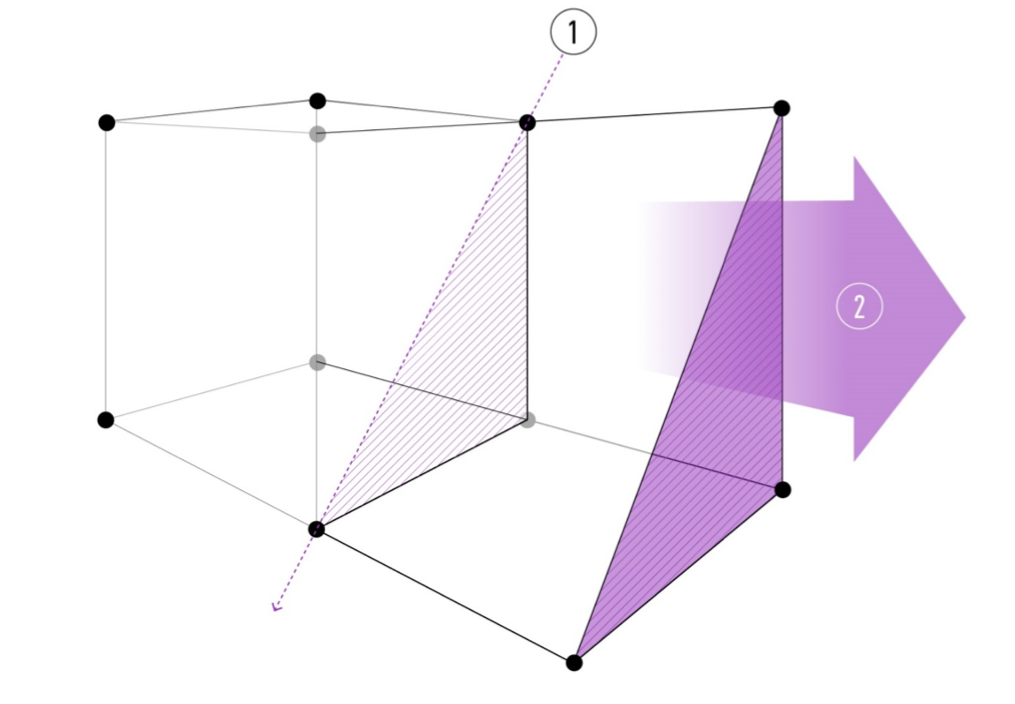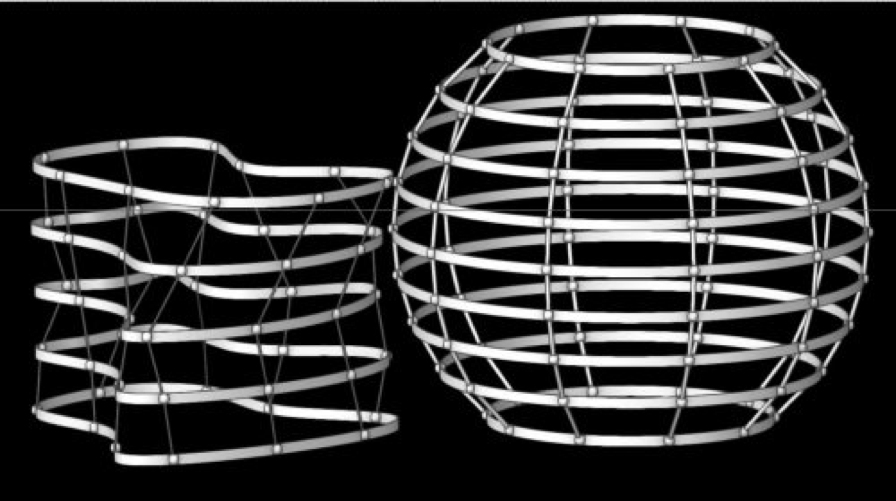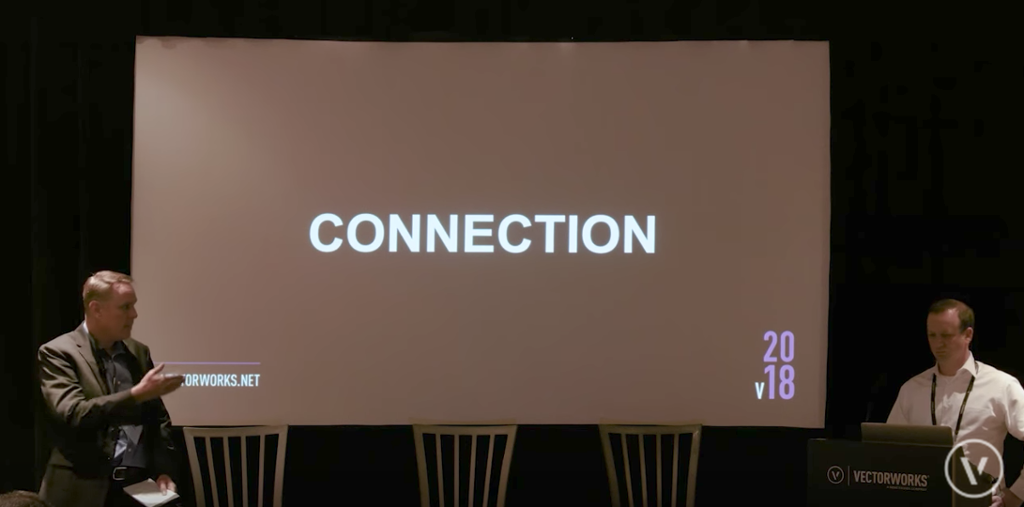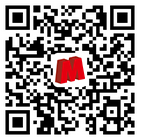When it comes to Vectorworks software, we always strive for quality, but for the 2018 latest release, we also wanted to focus on connection.

L to R: Dan Monaghan and Jeremy Powell discuss Vectorworks 2018.
“I’m always amazed at the benefits each new release of Vectorworks offers, and version 2018 is another huge release for us. But, more than the features, what stands out in 2018 is the thought the engineering team gave to how features work together. How the features in version 2018 connect to other features to create workflows — workflows that help solve problems and allow Vectorworks users to work faster and smarter,” says Dan Monaghan, vice president of marketing.
What are the top workflow benefits of Vectorworks 2018? Here are some insights from Monaghan, along with Jeremy Powell, senior marketing director at Vectorworks, Inc.
Q: Dan, you mentioned that 2018 focuses on connection. What does this mean?
Monaghan: Yes, you can see this theme of "connection" everywhere in this new release. How version 2018 connects modeling to drawings, connects design to analysis, connects models to presentation, and connects people to people with new ways to share and communicate designs.
Q: Can you give an example of a feature that connects in one of these ways?
Monaghan: Sure, one example is our new multiple drawing views feature. With this feature we make it easy for users to connect multiple views for faster and easier modeling and drafting. And, this connecting of models to drawings allows users to instantly see how a change in one view affects the other.
Powell: The benefit here is the tremendous modeling and documentation gains you receive. You can start an operation in one view pane and end it in another. You can start a rendering in one view and continue to model in another view. You can detail your documents in sheet layers — without waiting for the software, and without losing context.
Monaghan: And our implementation of multiple drawing views is pretty unique. In ArchiCAD, this basic BIM concept of working between views is completely missing. In Rhino, SketchUp, and other 3D modeling software there is no concept of a drawing, so seamlessly working between dawings and 3D is impossible. And, implementation in Revit is messy, meaning that the views are floating windows that are hard to manage and not interactive so you can’t start an operation in one view and finish it in another.
Q: So it sounds like the multiple drawing views feature is a great time saver. What other features can help our users with time constraints?
Monaghan: Improved subdivision modeling. Our subdivision capabilities are based on Pixar Animation Studio’s OpenSubdiv libraries. That gives us the ability to freely manipulate surfaces and solids to generate almost any 3D form.

Subdivision improvements
Q: Why would this be important, and how does this save time?
Monaghan: If you look at a typical BIM workflow in other softwares, you will mostly likely find designers are resorting to using SketchUp, Rhino, or another 3D program for early phase design. This is because you can’t freely interact with a BIM model in those programs; BIM edits are very prescribed and typically made by typing values into a dialog box — not very design friendly.
Powell: With these new subdivision modes, you can quickly sculpt any form. And then on top of that, you can put a cage around other 3D objects, and then subdivide and sculpt from there; you don’t always have to begin from nothing. It’s a huge time saver, and a wonderful way to create connection in the design process.
Monaghan: Connecting conceptual modeling, CAD, and BIM in one program offers users tremendous workflow advantages that save our users both time and money.
Q: Let’s talk about the design process a bit more. How else can Vectorworks 2018 aid the iterative design process?
Powell: Well, with Marionette in 2018, it’s easier to connect computational design approaches, because you can create scripts directly within Vectorworks, directly within the BIM environment. You aren’t forced to learn a separate application or store your code in proprietary formats. Marionette nodes use Python, the world’s most successful open-source scripting language.

Marionette graphical scripting tool
Monaghan: Vectorworks 2018 also offers new and improved ways to connect Vectorworks users to others involved in the design and construction process.
Powell: Right. Vectorworks and the Nemetschek Group have always been big proponents of openBIM, making it easy to share files and collaborate with others involved in the BIM process. That hasn’t changed. The only thing that has changed has been our focus on the accessibility and ease of use for creating IFC models and data exchange.
Q: I’m sure folks want to know more about accessing and managing data. Do any of the new features in 2018 help with this task?
Powell: Oh yes, in 2018 we made accessing and managing IFC data faster and easier. You no longer need to look through drop-down menus and multiple record formats to find and manage the IFC data in your model. You’re now able to access it and manage it directly from the Data pane in the Object Info palette. This is a fantastic new interface in Vectorworks that makes learning how to do openBIM in Vectorworks very simple.
Q: This all sounds great, but for a lot of our users, the bottom line is winning work with stellar presentation options. What can 2018 offer that helps designers snag more projects?
Powell: This year, we’re excited to have upgraded Renderworks to use CineRender R18 from our sister company MAXON, using rendering technologies that users did not have before, like better and faster interior lighting.
Monaghan: Also, designers often need to communicate to clients, some of whom can’t read 2D drawings. By connecting through presentation features like Renderworks, Vectorworks offers new ways for firms to set themselves apart from their competition.
Powell: And we’ve added 360-degree rendered panoramas. This is just a phenomenal new addition; you can share the completed project with your client, as well as put it on your website to promote and sell your creations.
Q: Speaking of selling, why don’t you sell us on Braceworks, our newest add-on module for Vectorworks Spotlight?
Powell: This brand-new addition has been a fantastic development. We announced it back in April. We’ve been working very hard with structural engineers, and major firms have been very involved. The result is just a tremendous new analysis engine. And going back to the theme of connection, the addition of Braceworks has given a total production package to the industry for the very first time. Now with Spotlight for design, Braceworks for analysis/engineering, and Vision for pre-visualization, entertainment designers have everything they need.

Vectorworks file for Eurovision Song Contest 2017. Image courtesy of Stephan Schewe.
Q: Any final thoughts before we close?
Monaghan: I just want to say that we’re really excited about the release of 2018. Again, not only because we were able to check off many items from our users’ wish lists, but also because of how these features connect together to provide some really great new workflows. I can’t wait to see what great things our users do with version 2018.
Powell: Yes, it’s very exciting. It’s amazing to see the direction we are heading with these new features and technologies. Not only to connect and share, but also how easy it is to do so!
Want to know more about Vectorworks 2018 and connect and learn about the features mentioned?
|





